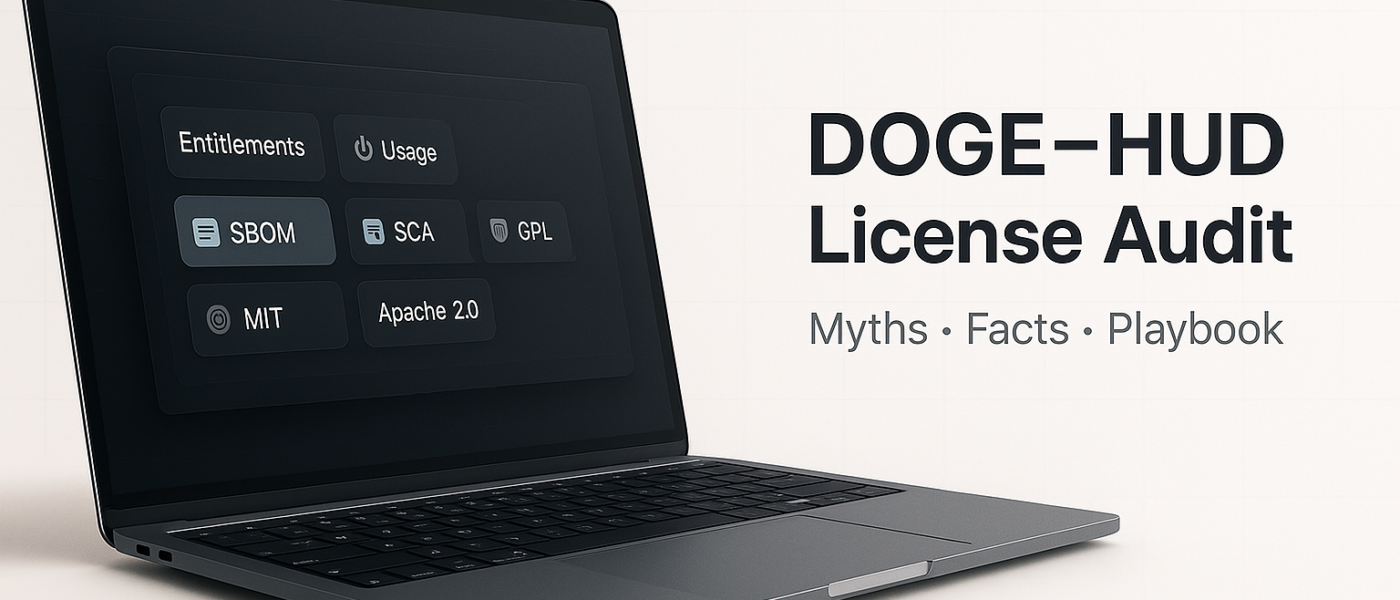DOGE Software Licenses Audit HUD: Myths, Facts & a Practical 10‑Step Playbook (2025)
What “DOGE software licenses audit HUD” actually means
News angle: In March 2025, posts and coverage amplified claims that HUD held thousands of paid licenses with little to no usage (e.g., “11,020 Adobe Acrobat licenses with zero users”), spurring debate about how such numbers are calculated and reported.
- Example coverage: Fox News
- Source posts: DOGE on X (initial findings)
- Receipts page: doge.gov/savings
Productivity angle: Teams also use “HUD” literally—an overlay that puts entitlements vs. usage, SBOM and policy outcomes where decisions happen: CI/CD, IDEs, and admin portals.
Myths vs Facts (context you can cite)
- Myth: “A big number of ‘unused’ licenses always equals waste.”
Fact: Enterprise pools can exist for migrations, device metrics, contractors, or surge capacity. Validate against contract terms and telemetry before calling waste. See the receipts page and independent reviews of the savings math. DOGE receipts · Politico analysis - Myth: “All claimed savings reduce the deficit.”
Fact: Media and analysts note many claims rely on contract ceilings, not obligated spend; reductions don’t automatically change appropriations. See Politico’s dataset review. Read - Myth: “Access limits stop audits.”
Fact: A Fourth Circuit ruling on Aug 12, 2025 allowed DOGE access to certain sensitive data—underscoring why governance and privacy controls matter during audits. Washington Post · Federal News Network
The 10‑step audit playbook (proprietary + open source)
- Set the scope. List titles, editions, and environments (prod/test/VDI). Attach renewal dates and contract metrics (per‑user, device, core).
- Extract ground truth. Export admin/IdP telemetry: assigned vs. active users, last‑used timestamps, feature usage. For open‑source, generate SBOMs per build.
- Normalize & reconcile. Map entitlements to usage; flag over‑assignment, under‑coverage, and reserve pools.
- Explain variances. For each “idle” pool, record a business rationale (migration, seasonal, contractor, device installs). This narrative avoids misreads.
- Rightsize. Reclaim inactive seats; downgrade premium SKUs with low feature usage; consolidate overlapping tools.
- Policy for OSS. Adopt a written license policy with allow/flag/deny rules; store at org/repo level with owners and expiry for exceptions. Use OSI/FSF references for license behavior. OSI list · FSF GPL/AGPL FAQ
- SBOM & SCA. Emit SBOMs in SPDX 3.0.1 and/or CycloneDX 1.6; run SCA to classify licenses and detect unknown/custom IDs.
- CI gates. Make license policy checks blocking for releases; fail builds on deny rules or unknown licenses.
- Governance & SSDF. Align with NIST SSDF (SP 800‑218) expectations for software supply‑chain practices; publish a compliance report each release.
- Renewal play. Use your telemetry to renegotiate floors, tiers, and bundles; separate one‑time clawbacks from run‑rate savings for honest finance math.
Designing a compliance “HUD” that engineers will use
A good HUD is signal‑dense, low‑friction, and sits where decisions are made.
- Inputs: Admin/IdP usage + SBOM registry + SCA results + policy DB.
- Surface: Entitlements vs. usage, license posture (allow/flag/deny), exceptions with expiry, and remediation tasks with owners/SLAs.
- Automation: SBOMs emitted per build (SPDX 3.0.1 / CycloneDX 1.6), policy engine evaluates on PR, alerts in Slack/Teams.
Governance: reports, metrics, and renewal math
- Reports: Monthly proprietary reconciliation + release‑level OSS compliance report (SBOM, license exceptions, obligations met).
- KPIs: % inactive seats reclaimed; % builds with SBOM; unknown licenses → 0; exceptions closed on time.
- Finance clarity: Break out run‑rate savings vs. one‑time recoveries; tie any “idle” pools to contract clauses.
Walkthrough: a 60‑day turnaround example
Day 0 baseline: 3,120 seats across 16 titles; 24% inactive; 6 unknown OSS licenses across three services.
Day 30: reclaim 520 seats; downgrade 90 premium SKUs; SBOM emitting on every build; policy in place with 4 flagged repos.
Day 60: run‑rate ↓ ~$268k; unknown licenses = 0; exceptions reduced to 2 (time‑boxed); renewal proposal uses utilization to lower contract floors.
FAQs
Does a big “unused license” number prove waste?
Not by itself. You need contract context and telemetry. Pools can be intentional. Validate before declaring “waste.”
What’s the difference between proprietary audits and OSS compliance?
Proprietary audits reconcile entitlements vs. usage. OSS compliance manages license obligations across transitive dependencies using SBOM + SCA.
Which SBOM format should we choose?
Use SPDX 3.0.1 and/or CycloneDX 1.6. Many teams publish both for interoperability.
Do AGPL obligations apply to SaaS?
AGPL includes a network‑use clause; users interacting with your modified AGPL service must have an option to receive source. See the FSF FAQ.
Bottom line
The headlines created urgency; the real win is a repeatable audit program plus a HUD‑style dashboard that keeps spend optimized and compliance clear. Use the playbook above, ship SBOMs on every build, and make license policy visible where work happens.
